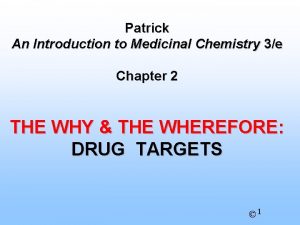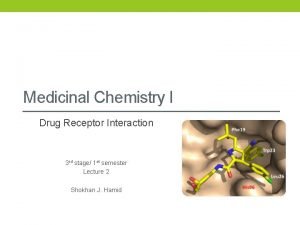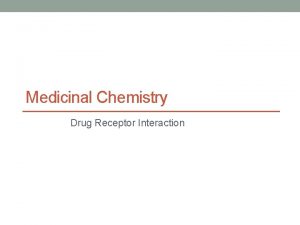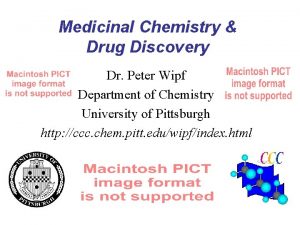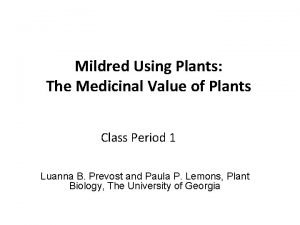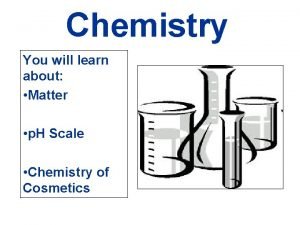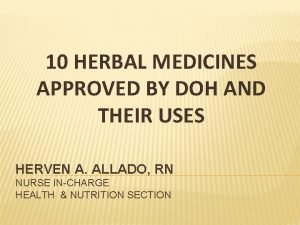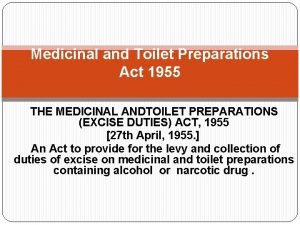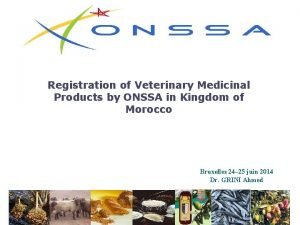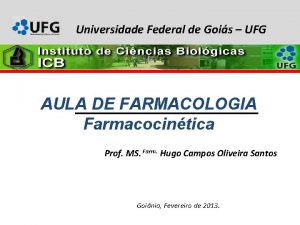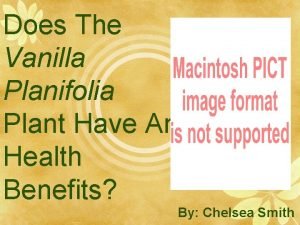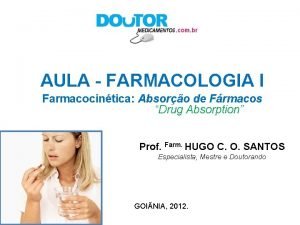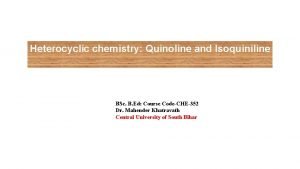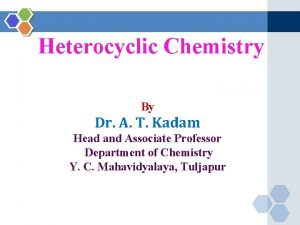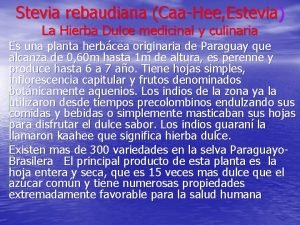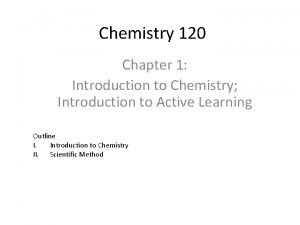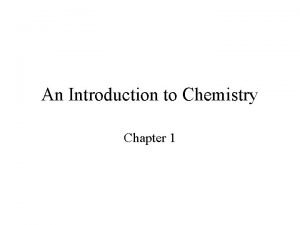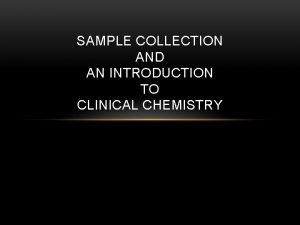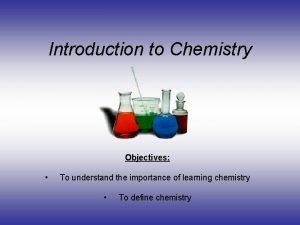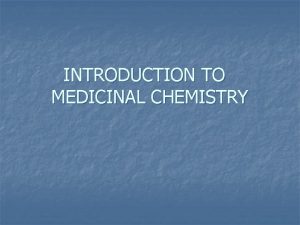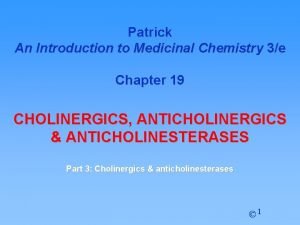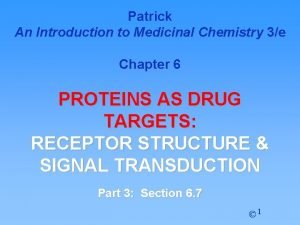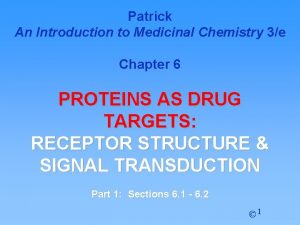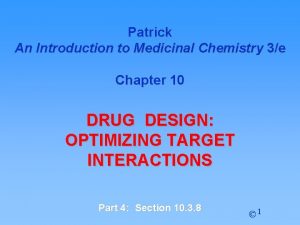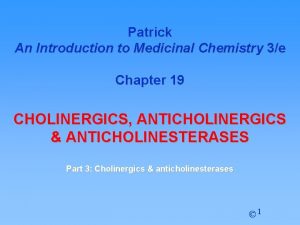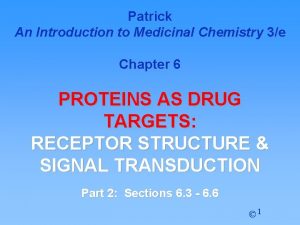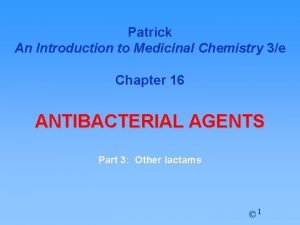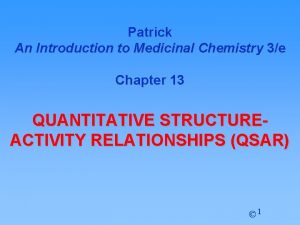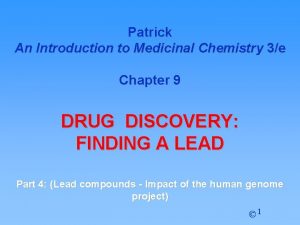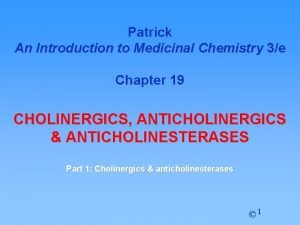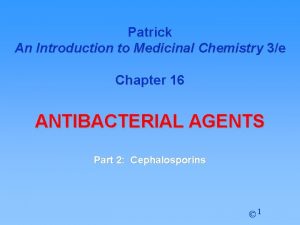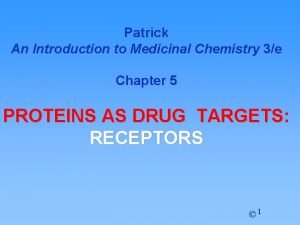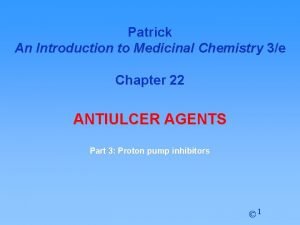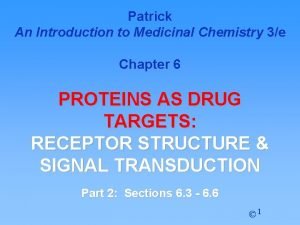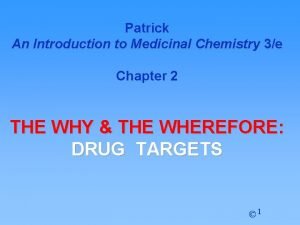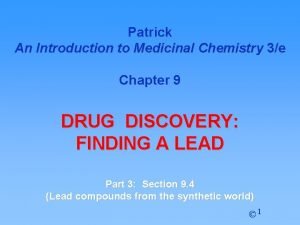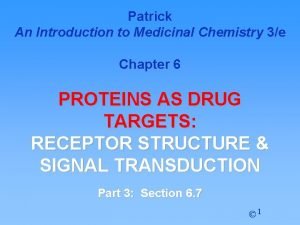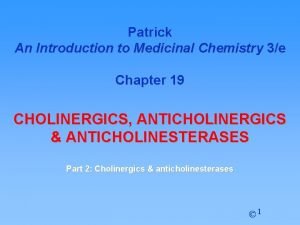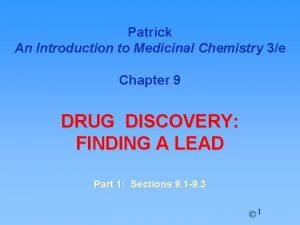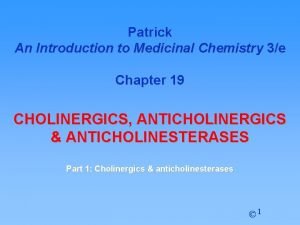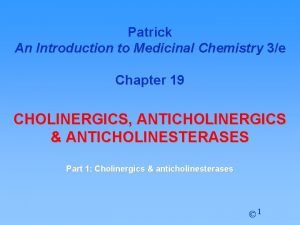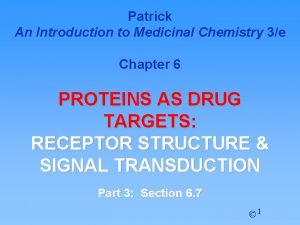Patrick An Introduction to Medicinal Chemistry 3e Chapter































- Slides: 31

Patrick An Introduction to Medicinal Chemistry 3/e Chapter 19 CHOLINERGICS, ANTICHOLINERGICS & ANTICHOLINESTERASES Part 2: Cholinergics & anticholinesterases © 1

Contents Part 2: Cholinergics & anticholinesterases 12. Cholinergic Antagonists (Muscarinic receptor) (2 slides) 12. 1. Atropine 12. 2. Hyoscine (scopolamine) 12. 3. Comparison of atropine with acetylcholine 12. 4. Analogues of atropine 12. 5. Simplified Analogues (2 slides) 12. 6. SAR for Antagonists (3 slides) 12. 7. Binding Site for Antagonists (2 slides) 13. Cholinergic Antagonists (Nicotinic receptor) 13. 1. Curare (2 slides) 13. 2. Binding 13. 3. Analogues of tubocurarine (5 slides) [22 slides] © 1

12. Cholinergic Antagonists (Muscarinic receptor) • • • Drugs which bind to cholinergic receptor but do not activate it Prevent acetylcholine from binding Opposite clinical effect to agonists - lower activity of acetylcholine Postsynaptic nerve Ach Ach Antagonist © 1

12. Cholinergic Antagonists (Muscarinic receptor) Clinical Effects • Decrease of saliva and gastric secretions • Relaxation of smooth muscle • Decrease in motility of GIT and urinary tract • Dilation of pupils Uses • Shutting down digestion for surgery • Ophthalmic examinations • Relief of peptic ulcers • Treatment of Parkinson’s Disease • Anticholinesterase poisoning • Motion sickness © 1

http: //www. fairview. org/healthlibrary/content/ma_atrosulf_ma. htm http: //www. medicinenet. com/atropine-oral/article. htm http: //healthresources. caremark. com/topic/parkinsondrugs © 1

Cycloplegia is the paralysis of the ciliary muscle, resulting in a loss of accommodation. Cycloplegic drugs, including atropine, cyclopentolate, succinylcholine, homatropine, scopolamine and tropicamide, are indicated for use in cycloplegic refractions and the treatment of uveitis. Other cycloplegic drugs include Neostigmine, Phentolamine and Pilocarpine mydriasis Mydriasis Classifications and external resources An abnormally dilated pupil. Mydriasis is an excessive dilation of the pupil due to disease or drugs. Although the pupil will normally dilate in the dark, it is usually quite constricted in the light. A mydriatic pupil will remain excessively large, even in a bright environment. Constriction of the pupil is called miosis © 1

12. Cholinergic Antagonists (Muscarinic receptor) 12. 1 Atropine easily racemised • • • Racemic form of hyoscyamine Source - roots of belladonna (1831) (deadly nightshade) Used as a poison Used as a medicine decreases GIT motility antidote for anticholinesterase poisoning dilation of eye pupils CNS side effects - hallucinations © 1

12. Cholinergic Antagonists (Muscarinic receptor) 12. 2 Hyoscine (scopolamine) • • • Source - thorn apple Medical use treatment of motion sickness Used as a truth drug (CNS effects) © 1

12. Cholinergic Antagonists (Muscarinic receptor) 12. 3 Comparison of atropine with acetylcholine • • • Relative positions of ester and nitrogen similar in both molecules Nitrogen in atropine is ionised Amine and ester are important binding groups (ionic + H-bonds) Aromatic ring of atropine is an extra binding group (vd. W) Atropine binds with a different induced fit - no activation Atropine binds more strongly than acetylcholine © 1

12. Cholinergic Antagonists (Muscarinic receptor) 12. 4 Analogues of atropine Ipratropium (bronchodilator & anti-asthmatic) • • • Atropine methonitrate (lowers GIT motility) Analogues are fully ionised Analogues unable to cross the blood brain barrier No CNS side effects © 1

The combination preparation ipratropium/salbutamol is a formulation containing ipratropium bromide and salbutamol sulfate (albuterol sulfate) used in the management of chronic obstructive pulmonary disease (COPD) and asthma. It is marketed by Boehringer Ingelheim as metered dose inhaler (MDI) and nebuliser preparations under the trade name Combivent. Medications commonly used in asthma and COPD (primarily R 03) edit Anticholinergics: Ipratropium, Tiotropium Short acting β 2 -agonists: Salbutamol, Terbutaline Long acting β 2 -agonists (LABA): Bambuterol, Clenbuterol, Fenoterol, Formoterol, Salmeterol Corticosteroids: Beclometasone, Budesonide, Ciclesonide, Fluticasone Leukotriene antagonists: Montelukast, Pranlukast, Zafirlukast Xanthines: Aminophylline, Theobromine, Theophylline Mast cell stabilizers: Cromoglicate, Nedocromil Combination products: Budesonide/formoterol, Fluticasone/salmeterol, Ipratropium/salbutamol Diphenoxylate is an opioid agonist used for the treatment of diarrhea that acts by slowing intestinal contractions. It was discovered at Janssen Pharmaceutica in 1956. It is a congener to the narcotic Meperidine of which the common brand name is Demerol. This being the case, this medication is potentially habit-forming, particularly in high doses or when long-time usage is involved. Because of this, diphenoxylate is manufactured and marketed as a combination drug with atropine (Lomotil®). This pharmaceutical strategy is designed to discourage abuse, because the anticholinergic effect of atropine will produce severe weakness and nausea if standard dosage is exceeded. This medication is classified as a Schedule V under the Controlled Substances Act by the Food and Drug Administration (FDA) and the DEA in the United States when used in preparations. When diphenoxylate is used alone, it is classified as a Schedule II. © 1

12. Cholinergic Antagonists (Muscarinic receptor) 12. 5 Simplified Analogues Pharmacophore = ester + basic amine + aromatic ring Amprotropine Tridihexethyl bromide Propantheline chloride © 1

12. Cholinergic Antagonists (Muscarinic receptor) 12. 5 Simplified Analogues Tropicamide (opthalmics) Cyclopentolate (opthalmics) Benzhexol (Parkinsons disease) Benztropine (Parkinsons disease) Pirenzepine (anti-ulcer) © 1

12. Cholinergic Antagonists (Muscarinic receptor) 12. 6 SAR for Antagonists R' = Aromatic or Heteroaromatic Important features • Tertiary amine (ionised) or a quaternary nitrogen • Aromatic ring • Ester • N-Alkyl groups (R) can be larger than methyl (unlike agonists) • Large branched acyl group • R’ = aromatic or heteroaromatic ring • Branching of aromatic/heteroaromatic rings is important © 1

12. Cholinergic Antagonists (Muscarinic receptor) 12. 6 SAR for Antagonists Active Inactive © 1

12. Cholinergic Antagonists (Muscarinic receptor) 12. 6 SAR for Antagonists vs. Agonists SAR for Antagonists SAR for Agonists Tertiary amine (ionised) or quaternary nitrogen Aromatic ring Ester N-Alkyl groups (R) can be larger than methyl R’ = aromatic or heteroaromatic Branching of Ar rings important Quaternary nitrogen Aromatic ring Ester N-Alkyl groups = methyl R’ = H © 1

12. Cholinergic Antagonists (Muscarinic receptor) 12. 7 Binding Site for Antagonists van der Waals binding regions for antagonists Acetylcholine binding site RECEPTOR SURFACE © 1

12. Cholinergic Antagonists (Muscarinic receptor) 12. 7 Binding Site for Antagonists © 1

13. Cholinergic Antagonists (Nicotinic receptor) 13. 1 Curare • Extract from ourari plant • Used for poison arrows • Causes paralysis (blocks acetylcholine signals to muscles) • Active principle = tubocurarine Tubocurarine © 1

Tubocurarine chloride is a competitive antagonist of nicotinic neuromuscular acetylcholine receptors, used to paralyse patients undergoing anaesthesia. It is one of the chemicals that can be obtained from curare, itself an extract of Chondodendron tomentosum, a plant found in South American jungles which is used as a source of arrow poison. Native indians hunting animals with this poison were able to eat the animal's contaminated flesh without being affected by the toxin because tubocurarine cannot easily cross mucous membranes and is thus inactive orally. The correct chemical structure was only elucidated circa 1970, even though the plant had been known since the Spanish Conquest. The word curare comes from the South American Indian name for the arrow poison: "ourare". Presumably the initial syllable was pronounced with a heavy glottal stroke. Tubocurarine is so called because the plant samples containing it were first shipped to Europe in tubes. Today, tubocurarine has fallen into disuse in western medicine, as safer synthetic alternatives such as atracurium are available. However, tubocurarine is still used in the United States and elsewhere as part of the lethal injection procedure. © 1

13. Cholinergic Antagonists (Nicotinic receptor) Pharmacophore • Two quaternary centres at specific separation (1. 15 nm) • Different mechanism of action from atropine based antagonists • Different binding interactions Clinical uses • Neuromuscular blocker for surgical operations • Permits lower and safer levels of general anaesthetic • Tubocurarine used as neuromuscular blocker but side effects © 1

13. Cholinergic Antagonists (Nicotinic receptor) 13. 2 Binding protein complex (5 subunits) diameter=8 nm S 8 nm 9 -10 nm a) Receptor dimer b) Interaction with tubocurarine Tubocurarine Acetylcholine binding site © 1

13. Cholinergic Antagonists (Nicotinic receptor) 13. 3 Analogues of tubocurarine Decamethonium • • • Long lasting Long recovery times Side effects on heart Suxamethonium • • Esters incorporated Shorter lifetime (5 min) Fast onset and short duration Side effects at autonomic ganglia © 1

Suxamethonium chloride From Wikipedia, the free encyclopedia (Redirected from Succinylcholine) Routes Intravenous Suxamethonium chloride (also known as succinylcholine, scoline, or SUX) is a white crystalline substance, it is odourless and highly soluble in water. The compound consists of two acetylcholine molecules that are linked by their acetyl groups. Suxamethonium is sold under several trademark names such as Anectine®, and may be referred to as "sux" for short. Suxamethonium acts as a depolarizing muscle relaxant. It imitates the action of acetylcholine at the neuromuscular junction, but it is not degraded by acetylcholinesterase but by pseudocholinesterase, a plasma cholinesterase. This hydrolysis by pseudocholinesterase is much slower than that of acetylcholine by acetylcholinesterase. There are two phases to the blocking effect of suxamethonium. The first is due to the prolonged stimulation of the acetylcholine receptor results first in disorganized muscle contractions (fasciculations, considered to be a side effect as mentioned below), as the acetylcholine receptors are stimulated. On stimulation, the acetylcholine receptor becomes a general ion channel, so there is a high flux of potassium out of the cell, and of sodium into the cell, resulting in an endplate potential less than the action potential. So, after the initial firing, the cell remains refractory. i © 1

Suxamethonium chloride On continued stimulation, the acetylcholine receptors become desensitised and close. This means that new acetylcholine signals do not cause an action potential; and the continued binding of suxamethonium is ignored. This is the principal anaesthetic effect of suxamethonium, and wears off as the suxamethonium is degraded, and the acetylcholine receptors return to their normal configuration. The side effect of hyperkalaemia is because the acetylcholine receptor is propped open, allowing continued flow of potassium ions into the extracellular fluid. A typical increase of potassium ion serum concentration on administration of suxamethonium is 0. 5 mmol per litre, whereas the normal range of potassium is 3. 5 to 5 mmol per litre: a significant increase which results in the other side-effects of ventricular fibrillation due to reduced to action potential initiation in the heart. Its medical uses are limited to short-term muscle relaxation in anesthesia and intensive care, usually for facilitation of endotracheal intubation. Despite its many undesired effects on the circulatory system and skeletal muscles (including malignant hyperthermia, a rare but life-threatening disease), it is perennially popular in emergency medicine because it arguably has the fastest onset and shortest duration of action of all muscle relaxants. Both are major points of consideration in the context of trauma care, where paralysis must be induced very quickly and the use of a longer-acting agent might mask the presence of a neurological deficit. A single intravenous dose of 1. 0 to 1. 5 milligrams per kilogram of body weight for adults or 2. 0 milligrams per kilogram for pediatrics will cause flaccid paralysis within a minute of injection. For intramuscular injection higher doses are used and the effects last somewhat longer. Suxamethonium is quickly degraded by plasma cholinesterase and the duration of effect is usually in the range of a few minutes. When plasma levels of cholinesterase are greatly diminished or an atypical form of cholinesterase is present (an otherwise harmless inherited disorder), paralysis may last much longer. © 1

13. Cholinergic Antagonists (Nicotinic receptor) 13. 3 Analogues of tubocurarine Pancuronium (R=Me) Vecuronium (R=H) • • • Steroid acts as a spacer for the quaternary centres (1. 09 nm) Acyl groups are added to introduce the Ach skeleton Faster onset then tubocurarine but slower than suxamethonium Longer duration of action than suxamethonium (45 min) No effect on blood pressure and fewer side effects © 1

13. Cholinergic Antagonists (Nicotinic receptor) 13. 3 Analogues of tubocurarine Atracurium • • Design based on tubocurarine and suxamethonium Lacks cardiac side effects Rapidly broken down in blood both chemically and metabolically Avoids patient variation in metabolic enzymes Lifetime is 30 minutes Administered as an i. v. drip Self destruct system limits lifetime © 1

Atracurium is a neuromuscular-blocking drug or skeletal muscle relaxant in the category of non-depolarising neuromuscular blocking agents, used adjunctively in anaesthesia to facilitate endotracheal intubation and to provide skeletal muscle relaxation during surgery or mechanical ventilation. Side effects owing to histamine liberation are rash, reflex increase in heart rate, low blood pressure and bronchospasm. It is a bisbenzyltetrahydroisoquinolinium mixture of 10 Stereoisomers. Atracurium was first synthesized, in 1974 by George H. Dewar, in John B. Stenlake's medicinal chemistry research group at Strathclyde University, Scotland. It is the first nondepolarising non-steroidal skeletal muscle relaxant rationally designed to undergo chemodegradation in vivo. Atracurium was licensed to Burroughs Wellcome Co. , which developed atracurium and eventually marketed it (as a mixture of all ten stereoisomers)under the name Tracrium. Atracurium's rate of degradation in vivo is influenced by p. H and temperature. Atracurium was succeeded by cisatracurium, which is the R-cis isomer constituent of atracurium. The pharamcodynamic and adverse effect profile of cisatracurium proved to be superior to that of atracurium. Cisatracurium was made available worldwide as Nimbex, with its clinical development solely undertaken by Burroughs Wellcome Co. 1 Atracurium is classified as an intermediate-acting neuromuscular blocking©agent.

Atracurium Pharmacokinetic data Bioavailability 100% (IV) Protein binding 82% Metabolism. Hoffman elimination (retro-Michael addition) and ester hydrolysis Half life 17 -21 minutes Excretion ? Routes IV Atracurium is a neuromuscular-blocking drug or skeletal muscle relaxant in the category of non-depolarising neuromuscular blocking agents, used adjunctively in anaesthesia to facilitate endotracheal intubation and to provide skeletal muscle relaxation during surgery or mechanical ventilation. Side effects owing to histamine liberation are rash, reflex increase in heart rate, low blood pressure and bronchospasm. It is a bisbenzyltetrahydroisoquinolinium mixture of 10 Stereoisomers. Atracurium was first synthesized, in 1974 by George H. Dewar, in John B. Stenlake's medicinal chemistry research group at Strathclyde University, Scotland. It is the first non-depolarising non-steroidal skeletal muscle relaxant rationally designed to undergo chemodegradation in vivo. Atracurium was licensed to Burroughs Wellcome Co. , which developed atracurium and eventually marketed it (as a mixture of all ten stereoisomers)under the name Tracrium. Atracurium's rate of degradation in vivo is influenced by p. H and temperature. Atracurium was succeeded by cisatracurium, which is the R-cis isomer constituent of atracurium. The pharamcodynamic and adverse effect profile of cisatracurium proved to be superior to that of atracurium. Cisatracurium was made available worldwide as Nimbex, with its clinical development solely undertaken by Burroughs Wellcome Co. Atracurium is classified as an intermediate-acting neuromuscular blocking age © 1

13. Cholinergic Antagonists (Nicotinic receptor) 13. 3 Analogues of tubocurarine ACTIVE INACTIVE Atracurium stable at acid p. H Hofmann elimination at blood p. H (7. 4) © 1

13. Cholinergic Antagonists (Nicotinic receptor) 13. 3 Analogues of tubocurarine Mivacurium • • Faster onset (2 min) Shorter duration (15 min) © 1
 Patrick: an introduction to medicinal chemistry 3e
Patrick: an introduction to medicinal chemistry 3e Medicinal chemistry lectures
Medicinal chemistry lectures Drug receptor interaction medicinal chemistry
Drug receptor interaction medicinal chemistry Drug receptor interaction medicinal chemistry
Drug receptor interaction medicinal chemistry Peter wipf pitt
Peter wipf pitt Jewel weed medicinal
Jewel weed medicinal Objectives of medicinal plants
Objectives of medicinal plants Mixtures of organic substances and a medicinal agent are:
Mixtures of organic substances and a medicinal agent are: Benefits of tsaang gubat
Benefits of tsaang gubat Quality control methods for medicinal plant materials
Quality control methods for medicinal plant materials Define medicinal plants
Define medicinal plants Medicinal preparation definition
Medicinal preparation definition Gas medicinal
Gas medicinal Veterinary medicinal product dossier
Veterinary medicinal product dossier Transporte ativo
Transporte ativo Medicinal algae
Medicinal algae Vanilla planifolia medicinal uses
Vanilla planifolia medicinal uses Quimica medicinal
Quimica medicinal Medicinal algae
Medicinal algae Synthesis of quinoline from aniline
Synthesis of quinoline from aniline Pyrrole medicinal uses
Pyrrole medicinal uses Cosechadora de stevia
Cosechadora de stevia Calyptocarpus vialis medicinal uses
Calyptocarpus vialis medicinal uses Mitstudie au
Mitstudie au Chapter 1 introduction to chemistry
Chapter 1 introduction to chemistry Introduction to chemistry chapter 1
Introduction to chemistry chapter 1 Ib chemistry organic chemistry
Ib chemistry organic chemistry Organic vs inorganic chemistry
Organic vs inorganic chemistry Introduction to clinical laboratory
Introduction to clinical laboratory Importance of pharmaceutical inorganic compound
Importance of pharmaceutical inorganic compound Organic vs inorganic compounds
Organic vs inorganic compounds Aims and objectives of chemistry
Aims and objectives of chemistry
